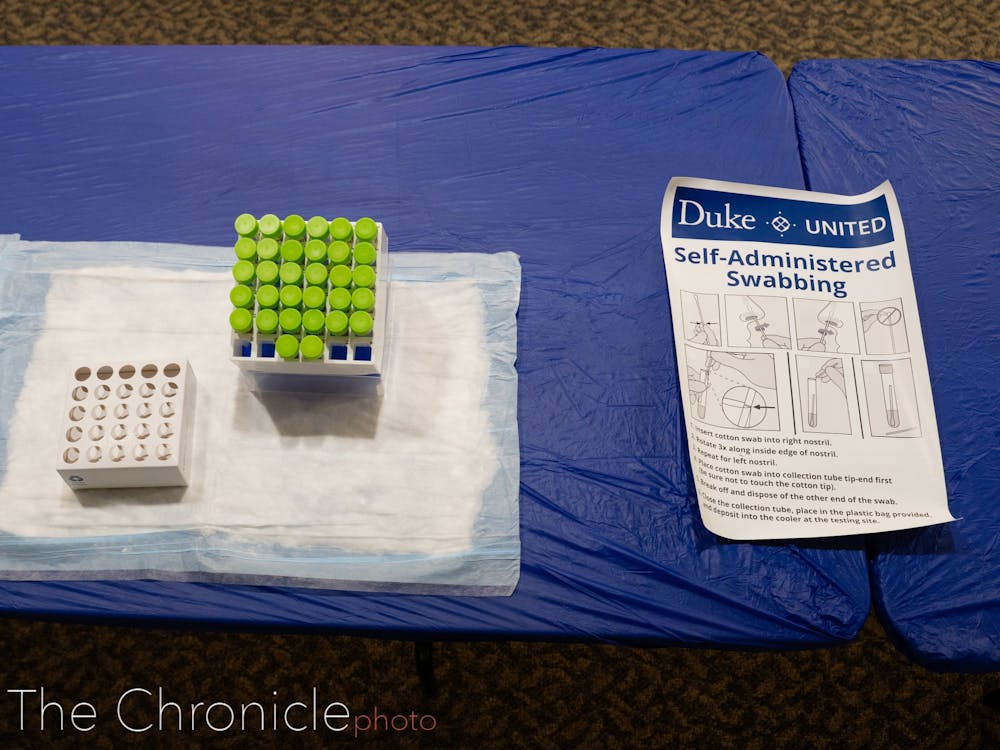“Message from Duke United Testing: As a reminder, you are scheduled for a surveillance test today. This test is required, even if you recently completed a COVID-19 test.”
Many students have become accustomed to seeing this message in their inbox one or more times per week.
During each week since Jan. 11, Duke has conducted more surveillance tests for asymptomatic students, faculty and staff than any week last semester. Surveillance testing excludes entry tests and contact-tracing tests for those who report symptoms and are contact traced.
Duke conducted a total of 25,625 surveillance tests on students and faculty last week, 27,264 surveillance tests between Jan. 18 and 24 and 16,666 surveillance tests between Jan. 11 and 17.
In its first testing update for the fall 2020 semester, Duke reported that it had conducted 6,370 tests between Aug. 2 and 15. From there, surveillance testing increased. The highest amount of surveillance tests conducted in a week last semester was 15,840, between Nov. 7 and 13. Vice President of Administration Kyle Cavanaugh told The Chronicle in October that since Aug. 13, Duke had aimed for around 10,000 tests per week in the fall semester.
“Last semester, as we were ramping up, we did not get to a full schedule of surveillance testing until about a month into the semester,” Cavanaugh wrote in an email to The Chronicle this month. “This semester, we were able to start surveillance testing for all students immediately following gateway testing.”
Cavanaugh wrote that for the spring 2021 semester, Duke’s surveillance testing program will be conducting more than 20,000 tests each week.
“Each student is projected to be tested at least once per week, and based upon developments from the previous week, a student may be tested more frequently,” Cavanaugh wrote.
Duke adjusts the testing frequency and population based on the data of what is happening on campus and in the community. “For example,” Cavanaugh wrote, “we had more off campus undergraduates test positive last week, so that population was tested twice this week.”
Cavanaugh explained that Duke administrators planned to scale up surveillance testing because of higher COVID-19 rates nationwide.
“It’s obvious that the prevalence of COVID-19 is significantly higher today than it was in the fall in every state across the country and we have adjusted our testing plan to account for that,” Cavanaugh wrote.
Although the magnitude of testing has increased this semester, Cavanaugh noted that the cost estimate for the spring “remains the same as it did in the fall.”
In the fall, surveillance testing was estimated to cost “several million dollars” throughout the academic year, according to Michael Schoenfeld, vice president for public affairs and government relations.
Four weeks into releasing testing updates for the spring semester, Duke’s coronavirus case numbers have already surpassed the total from the fall semester. Since Jan. 3, there have been 296 cases among students, faculty, and staff. In comparison the entire fall semester saw 241 cases.
“Our testing plan has continued to involve baseline or gateway testing, surveillance testing, and testing for symptomatic individuals,” Cavanaugh wrote. “Duke continues to have a comprehensive testing program as part of our overall strategy in keeping our community safe.”
Get The Chronicle straight to your inbox
Sign up for our weekly newsletter. Cancel at any time.

